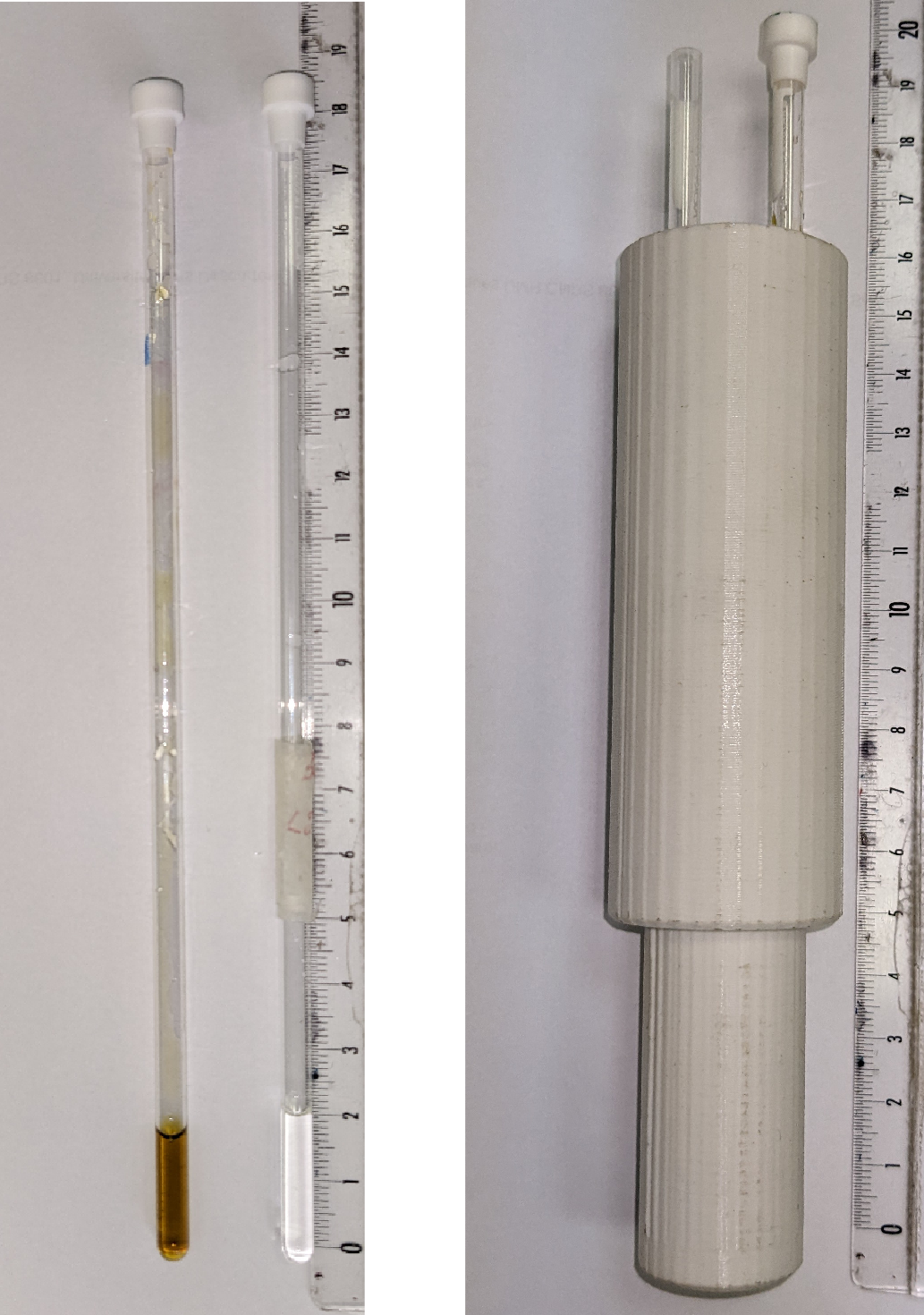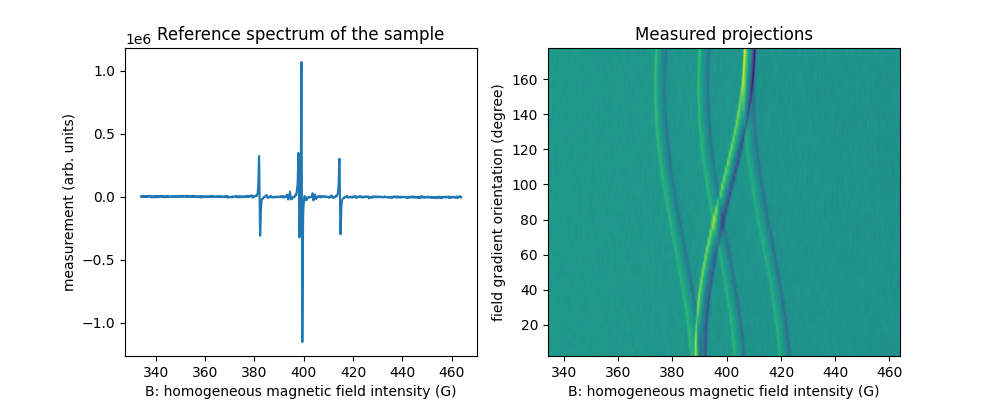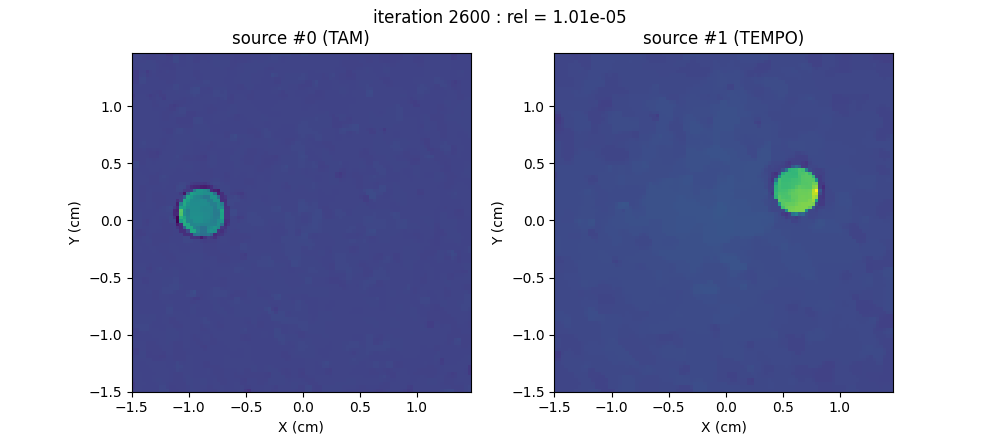Note
Go to the end to download the full example code.
Separation of TAM & TEMPO tubes (real 2D dataset)
Simultaneous image reconstruction and separation of sample made of one tube filled with a solution of TAM and one tube filled with a solution of TEMPO (see here for the sample and the dataset description).

Picture of the sample.
Import needed modules
import math # basic math functions
import numpy as np # for array manipulations
import matplotlib.pyplot as plt # tools for data visualization
import pyepri.backends as backends # to instanciate PyEPRI backends
import pyepri.datasets as datasets # to retrieve the path (on your own machine) of the demo dataset
import pyepri.displayers as displayers # tools for displaying images (with update along the computation)
import pyepri.processing as processing # tools for EPR image reconstruction
import pyepri.io as io # tools for loading EPR datasets (in BES3T or Python .PKL format)
Create backend
We create a numpy backend here because it should be available on your system (as a mandatory dependency of the PyEPRI package). You can try another backend (if available on your system) by uncommenting the appropriate line below (using a GPU backend may drastically reduce the computation time).
backend = backends.create_numpy_backend() # default numpy backend (CPU)
#backend = backends.create_torch_backend('cpu') # uncomment here for torch-cpu backend (CPU)
#backend = backends.create_cupy_backend() # uncomment here for cupy backend (GPU)
#backend = backends.create_torch_backend('cuda') # uncomment here for torch-gpu backend (GPU)
Load the input dataset
We load the tam-and-tempo-tubes-2d-20210609 dataset (embedded
with the PyEPRI package) in float32 precision. Take a look to
the comments for changing the precision to float64 or replacing
the embedded dataset by one of your own dataset. Note that to adapt
this example to your own dataset, you will need to provide
the sequence of measured projection of the sample (mixture of multiple EPR species);
the reference spectrum of each EPR species present in the sample (must be calculated beforehand, preferably extracted from the reference spectrum of the mixture).
# set the path towards the measured projections (mixture of TAM & TEMPO)
path_proj = datasets.get_path('tam-and-tempo-tubes-2d-20210609-proj.pkl') # or use your own dataset, e.g., path_proj = '~/my_projections.DSC'
# set the paths towards the reference spectra of each EPR species
# present in the mixture (in this dataset, the reference spectra of
# the single species were fited from the ref. spectrum of the mixture)
path_htam = datasets.get_path('tam-and-tempo-tubes-2d-20210609-htam.pkl') # or use your own dataset, e.g., path_htam = '~/my_tam_spectrum.DSC'
path_htempo = datasets.get_path('tam-and-tempo-tubes-2d-20210609-htempo.pkl') # or use your own dataset, e.g., path_htempo = '~/my_tempo_spectrum.DSC'
# load the dataset in float32 precision
dtype = 'float32' # use 'float32' for single (32 bit) precision and 'float64' for double (64 bit) precision
dataset_proj = io.load(path_proj, backend=backend, dtype=dtype) # load the dataset containing the projections
dataset_htam = io.load(path_htam, backend=backend, dtype=dtype) # load the dataset containing the TAM reference spectrum
dataset_htempo = io.load(path_htempo, backend=backend, dtype=dtype) # load the dataset containing the TEMPO reference spectrum
# extract data from the loaded datasets
B = dataset_proj['B'] # B sampling nodes
proj_mixture = dataset_proj['DAT'] # projections data
fg = dataset_proj['FGRAD'] # field gradient vectors coordinates
h_tam = dataset_htam['DAT'] # reference spectrum of the TAM
h_tempo = dataset_htempo['DAT'] # reference spectrum of the TEMPO
Display the input dataset
Before addressing the source separation problem, let us take a look at the measured reference spectrum of the sample (TAM + TEMPO mixture) as well as to the measured projections.
# prepare display
plt.figure(figsize=(10, 4))
theta = backend.arctan2(fg[1], fg[0])
proj_extent = [t.item() for t in (B[0], B[-1], theta[0]*180./math.pi, theta[-1]*180./math.pi)]
# display reference spectrum of the sample (contains one tube of TAM
# and one tube of TEMPO)
plt.subplot(1, 2, 1)
plt.plot(backend.to_numpy(B), backend.to_numpy(h_tam + h_tempo))
plt.xlabel("B: homogeneous magnetic field intensity (G)")
plt.ylabel("measurement (arb. units)")
plt.title("Reference spectrum of the sample")
# display measured projections
plt.subplot(1, 2, 2)
plt.imshow(backend.to_numpy(proj_mixture), extent=proj_extent, aspect='auto')
plt.title("Measured projections")
plt.xlabel("B: homogeneous magnetic field intensity (G)")
_ = plt.ylabel("field gradient orientation (degree)")

Perform source separation
Now let us perform the source separation, that is, the reconstruction of one image of the tube of TAM and one image of the tube of TEMPO.
# ----------------------------- #
# Set reconstruction parameters #
# ----------------------------- #
tam_shape = (100, 100) # required shape (number of pixels along each axe) for the output TAM source
tempo_shape = (100, 100) # required shape (number of pixels along each axe) for the output TEMPO source
out_shape = (tam_shape, tempo_shape) # output multisource image shape
delta = 3e-2 # sampling step in the same length unit as the provided field gradient coordinates (here cm)
lbda = 5 # normalized regularity parameter (arbitrary unit)
proj = (proj_mixture,) # list of input experiments (here only one experiment)
h = ((h_tam, h_tempo),) # list of source spectra associated to each experiment
fgrad = (fg,) # list of field gradient vectors associated to each experiment
# ----------------------- #
# Set optional parameters #
# ----------------------- #
nitermax = 5000 # maximal number of iterations
verbose = False # disable console verbose mode
video = True # enable video display
Ndisplay = 20 # refresh display rate (iteration per refresh)
eval_energy = False # disable TV-regularized least-square energy
# evaluation each Ndisplay iteration
# ---------------------------------------------------------- #
# Customize 2D multi-sources image displayer (optional, used #
# only when video=True above) #
# ---------------------------------------------------------- #
tam_shape = out_shape[0]
tempo_shape = out_shape[1]
xgrid_tam = (-(tam_shape[1]//2) + np.arange(tam_shape[1])) * delta
ygrid_tam = (-(tam_shape[0]//2) + np.arange(tam_shape[0])) * delta
xgrid_tempo = (-(tempo_shape[1]//2) + np.arange(tempo_shape[1])) * delta
ygrid_tempo = (-(tempo_shape[0]//2) + np.arange(tempo_shape[0])) * delta
grid_tam = (ygrid_tam, xgrid_tam)
grid_tempo = (ygrid_tempo, xgrid_tempo)
grids = (grid_tam, grid_tempo) # provide spatial sampling grids for each source
unit = 'cm' # provide length unit associated to the grids (used to label the image axes)
display_labels = True # display axes labels within subplots
adjust_dynamic = True # maximize displayed dynamic at each refresh
boundaries = 'same' # give all subplots the same axes boundaries (ensure same pixel size for
# each displayed slice)
figsize = (10., 4.4) # size of the figure to be displayed
src_labels = ('TAM', 'TEMPO') # source labels (to be included into suptitles)
displayer = displayers.create_2d_displayer(nsrc=2,
units=unit,
figsize=figsize,
adjust_dynamic=adjust_dynamic,
display_labels=display_labels,
boundaries=boundaries,
grids=grids,
src_labels=src_labels)
# --------------------------------------------------------------------- #
# Configure and run the TV-regularized multisource image reconstruction #
# --------------------------------------------------------------------- #
out = processing.tv_multisrc(proj, B, fgrad, delta, h, lbda,
out_shape, backend=backend, tol=1e-5,
nitermax=nitermax,
eval_energy=eval_energy, video=video,
verbose=verbose, Ndisplay=Ndisplay,
displayer=displayer)

Total running time of the script: (0 minutes 6.445 seconds)
Estimated memory usage: 263 MB